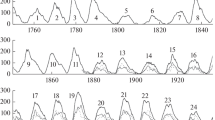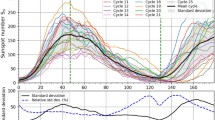Abstract
We propose a new technique for the optimal prediction of the peak of the next 11-year activity cycle prior to the cycle beginning and of the peaks of several succeeding cycles on the basis of long-term variations in the solar radius or solar constant. The method is based on the already established fact that the long-term cyclic variations of the activity, radius, and solar constant are correlated in both phase and amplitude, since they are caused by some common processes in the Sun. The peak of the succeeding cycle 24 is expected to have the height W max = 70 ± 10 (in units of relative sunspot number). The subsequent cycles 25 and 26, which will be formed during the descent of the current secular cycle, will have still lower peaks with the heights W max = 50 ± 15 and W max = 35 ± 20.
Similar content being viewed by others
References
Abdusamatov, Kh.I., Long-Term Variations of the Integral Radiation Flux and Possible Temperature Changes in the Solar Core, Kinematika i Fizika Nebes. Tel, 2005, vol. 21, no. 6, pp. 471–477.
Abdusamatov, Kh.I., Decrease of the Solar Radiation Flux and Drastic Fall of the Global Temperature on the Earth in the Middle of the XXI Century, Izv. Krym. Astrofiz. Observ., 2006, vol. 103, pp. 122–127.
Abdusamatov, Kh.I., The Time of the End of the Current Solar Cycle and the Relationship between Duration of 11-Year Cycles and Secular Cycle Phase, Kinematika i Fizika Nebes. Tel, 2006, vol. 22, no. 3, pp. 183–186.
Abdusamatov, Kh.I., Alekseev, Yu.V., Antoshkov, A.A., et al., The “Astrometry” Experiment on the Measurements of Temporal Variations in the Shape and Diameter of the Sun Aboard the Russian Segment of the International Space Station, Izv. RAN. Ser. Fiz., 2007, vol. 71, no. 4, pp. 556–561.
Ishkov, V.N., The Sun in the Current Solar Activity Cycle 23, Abstracts of Papers, IX Pulkovskaya mezhdunarodnaya konferentsiya po fizike Solntsa “Solnechnaya aktivnost’kak faktor kosmicheskoi pogody” (The IX Int. Pulkovo Conf. on Solar Physics “Solar Activity As a Space Weather Factor”), St. Petersburg, 2005, p. 69.
Kaftan, V.I., Kinematic Modeling of the Solar Activity. Forecast for Solar Cycle 24, Abstracts of Papers, Vserossiiskaya konferentsiya “Eksperimental’nye i teoreticheskie issledovaniya osnov prognozirovaniya geliogeofizicheskoi aktivnosti” (The All-Russian Conf. on Experimental and Theoretical Studies on Foundations of Heliogeophysical Activity Prediction), Troitsk, 2005, p. 33.
Miletskii, E.V. and Ivanov, V.G., Dynamical Models for the Long-Term Prediction of the Solar Activity, Abstracts of Papers, Vserossiiskaya konferentsiya “Eksperimental’nye i teoreticheskie issledovaniya osnov prognozirovaniya geliogeofizicheskoi aktivnosti” (The All-Russian Conf. on Experimental and Theoretical Studies on Foundations of Heliogeophysical Activity Prediction), Troitsk, 2005, p. 51.
Mordvinov, A.V., Makarenko, N.G., Junger, H., and Kramynin, A.P., Empirical Model of the Solar Impact on the Terrestrial Climate and Forecast for Cycle 24, Trudy IX Pulkovskoi mezhdunarodnoi konferentsii po fizike Solntsa “Solnechnaya aktivnost’ kak faktor kosmicheskoi pogody” (Proc. of the IX Int. Pulkovo Conf. on Solar Physics “Solar Activity As a Space Weather Factor”), St. Petersburg, 2005, pp. 197–202.
Callebaut, D.K. and Makarov, V.I., The Advent of a Grand Minimum and Climate Effects, Trudy IX Pulkovskoi mezhdunarodnoi konferentsii po fizike Solntsa “Solnechnaya activnost’ kak factor kosmicheskoi pogody” (Proc. of the IX Int. Pulkovo Conf. on Solar Physics “Solar Activity As a Space Weather Factor”), St. Petersburg, 2005, pp. 161–168.
Duhau, S., An Early Prediction of Maximum Sunspot Number in Solar Cycle 24, Solar Phys., 2003, vol. 213, pp. 203–212.
Sello, S., Solar Cycle Activity: A Preliminary Prediction for Cycle 24, Astron. and Astrophys., 2003, vol. 401, pp. 691–693.
Author information
Authors and Affiliations
Additional information
Original Russian Text © Kh.I. Abdusamatov, 2007, published in Kinematika i Fizika Nebesnykh Tel, 2007, Vol. 23, No. 3, pp. 141–147.
About this article
Cite this article
Abdusamatov, K.I. Optimal prediction of the peak of the next 11-year activity cycle and of the peaks of several succeeding cycles on the basis of long-term variations in the solar radius or solar constant. Kinemat. Phys. Celest. Bodies 23, 97–100 (2007). https://doi.org/10.3103/S0884591307030026
Received:
Issue Date:
DOI: https://doi.org/10.3103/S0884591307030026




